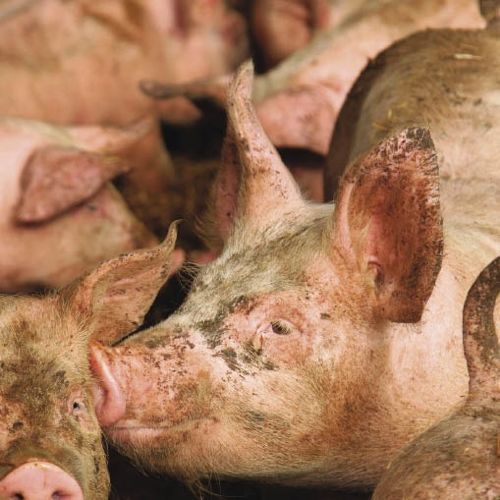The Canadian Food Inspection Agency says testing has been unable to confirm a link between pig feed containing blood plasma and an outbreak of porcine epidemic diarrhea (PED) in Eastern Canada.
But an Ontario vet on the front lines of that province’s outbreak says a common source of feed is the only thing linking the 18 operations, including one in P.E.I., that have been affected.
Dr. Doug MacDougald, a veterinarian with South West Ontario Veterinary Services who has worked with some of the first herds to be infected in Canada, takes issue with the way the CFIA reported the testing results, alleging that it “confuses the facts” and “absolutely smacks of government obfuscation.”
Read Also

Hands-on with agriculture draws students to AG EX
Urban students flock to MooMania and EweMania at Manitoba AG EX 2025 to get a taste of cattle and sheep production and where their food comes from
CFIA spokesman Guy Gravelle said testing showed that the porcine blood plasma used as a feed ingredient contained PED virus capable of causing disease in pigs. But further study, which involved feeding the feed pellets containing the plasma to pigs, did not cause disease.
“In line with our commitment to science, the agency will continue to analyze feed and feed ingredients, as well as epidemiological information gathered during the investigation, in order to verify that CFIA controls continue to protect Canadian livestock,” wrote Gravelle, citing a posting on the CFIA’s website dated March 3.
“In addition, the CFIA will examine any new lines of inquiry related to feed that may emerge, in particular from ongoing testing in Canada and the U.S.”
Wrong message
MacDougald, speaking as a private veterinarian working with the producers impacted by PED, in his personal opinion, said the CFIA has sent a “completely wrong” message to the North American hog industry because it omits important facts related to the outbreak and has left the “clear impression” that feed is not involved in PED in Canada.
“Here’s the conclusion: the epidemiology clearly links this live PED virus contaminated plasma shipment to 18 infected herds that are geographically diverse – they include a herd in P.E.I. – and have no other remotely identified linkages,” said MacDougald, who is currently chair of the Ontario Swine Health Advisory Board.
The bioassay only tested a small amount of feed on a small number of pigs, he added.
“The failure of the complete feed swine bioassay is moot at best, given these facts, and does not detract from the obvious conclusion on the spread of PED virus in Canada.”
The contaminated shipment was used to make “many tonnes” of feed, and the fact that a small sample failed to infect the test group of pigs doesn’t change the reality that contaminated feed is directly linked to at least 18 cases in Ontario and P.E.I.
“It’s like searching for a needle in a haystack to find live virus in the tonnes of feed,” said MacDougald.
“I can’t speculate where the gap in the quality control process was. I do know that samples were taken from each of the remaining 190 sealed bags of plasma and in pooled testing, every one was positive for PED virus,” he said.
More from the Manitoba Co-operator website: What is spray-dried porcine plasma?
Sampling continues
He conceded cross-contamination in some other way was possible, but he considers it unlikely.
“I can’t speculate where the gap in the process was. We’re just on the ground tracking a pattern of disease and now trying to contain it,” he said.
Louis Russell, CEO of American Protein Corporation, said the data clearly shows the feed was not the vector for the spread.
“CFIA explained that feed, containing porcine plasma, did not infect pigs with PED virus,” said Russell, in response to an email query.
“It is important that CFIA and industry continue working together to identify how this virus is spread. Until this is understood, the swine industry continues to be at risk from this disease.”
The CFIA also stated that its investigation so far has included sampling and testing of feed, plasma and other feed ingredients from various Canadian and U.S. sources associated with farms in Canada on which PED has been detected.
All test results on these samples were negative for PED.
The feed investigation was triggered on Feb. 9, after Ontario Ministry of Agriculture and Food (OMAF) testing found that U.S.-origin porcine blood plasma used in feed pellets produced by Grand Valley Fortifiers contained PED virus genetic material.
As a precautionary measure, Grand Valley Fortifiers voluntarily withdrew the potentially affected feed pellets from the marketplace.
Samples of both the feed pellets and the porcine blood plasma ingredient were submitted to the CFIA’s National Centre for Foreign Animal Disease (NCFAD) for further testing.
It was confirmed that both the blood plasma and the feed pellets contained PED virus genetic material; however, a bioassay study was required to confirm if this genetic material could cause illness in pigs.
PED can spread rapidly through contact with sick animals, as well as through people’s clothing, hands, equipment, boots and other tools contaminated with the feces of infected animals.
Manitoba PEDv case not feed related
Manitoba’s Office of the Chief Veterinary Officer (CVO) says its investigation into the province’s single reported case of PED so far has ruled out feed and the movement of an infected pig on to the farm as possible sources of infection.
Officials tested samples from all of the farm premises that had contact with the infected farm. To date, tests from 60 premises have been completed and confirmed negative for PED.
PED is a now reportable disease in Manitoba and veterinarians have received updated information from the Office of the CVO on the requirements to report suspected cases of PED. The rapid-detection monitoring program for facilities that move or handle large numbers of pigs continues.
There are now 27 farm premises that have tested positive for PED across Canada including one in Manitoba, one in Prince Edward Island, one in Quebec and 24 in Ontario.
U.S. deadly pig virus cases rise
Cases of the deadly porcine epidemic diarrhea virus, a highly contagious pig disease, are increasing across the U.S. Farm Belt, a group of animal health researchers said.
Confirmed cases of PEDv increased by 252 in the week ending March 1, bringing the total number to 4,106 in 26 states, according to data released March 6 by the U.S. Department of Agriculture’s National Animal Health Laboratory Network.
While one case can represent an individual animal or an entire herd at a single site, swine specialists estimate PEDv has killed at least four million U.S. hogs since it was discovered in May 2013.
Pork processors were finding it more difficult to purchase hogs for slaughter due to the virus, which is starting to affect the pork supply and could eventually boost pork prices for consumers, industry sources said.
The Canadian Swine Health Board has confirmed that four provinces also have cases of the virus. The provinces are Manitoba, Ontario, Prince Edward Island and Quebec.
PEDv causes diarrhea, vomiting and severe dehydration in pigs. While older pigs have a chance of survival, 80 to 100 per cent of piglets that contract it die.















